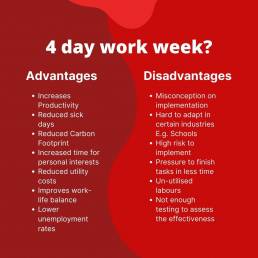The 4-day workweek has recently been one of the most controversial topics relating to workplace culture and productivity.
Since COVID-19 disrupted the world, organisations have identified the importance of work-life balance, workplace culture, and safety for all worker’s wellbeing. Organisations have been required to amend their workplace conditions to ensure their employees can perform their functions in a safe environment without the risk of contracting COVID-19. To achieve this, organisations implemented remote working practices for their employees to utilise such as Working from Home and Remote Conferencing. Working From Home has been an effective procedure to utilise during the pandemic, however, sustains major communication barriers that negatively impact worker’s productivity and morale for the business. To improve the work-life balance, workplace culture, and safety for worker’s wellbeing, organisations are continuously seeking new concepts that can be implemented to improve the morale of their employees. One concept that is being extensively researched by major corporations to improve workers morale is the 4-day work week.
The 4-day work week concept enables workers to work 4 days a week while earning the conventional 5-day wage/salary. The concept focuses on increasing the output of worker’s productivity at their job while sustaining an improved work-life balance for worker’s lifestyles. The concept articulates how a reduction of 1 working day enables workers to feel more refreshed when coming to work, accompanied by improved morale which attributes to greater relationships between workers and the business they work for.
The 4-day work week concept has been trialled by major corporations Microsoft and Unilever to determine if the concept is effective. According to The Business Insider Australia 2019, Microsoft Japan discovered their labour productivity increased by 39.9% in August 2019 using the 4-day work week concept, compared to August 2018 which used the conventional 5-day work week. The results displayed workers were more productive when they were rested and more efficient in their time management skills. Although Microsoft had great success with the 4-day workweek concept, there are concerns the 4-day work week concept will not be effective for all industries and business models.
The 4-day work week concept has also been trialled by the Spanish government. According to Reasons To Be Cheerful 2021, up to 400 Spanish companies will utilise the 4 day work week in their business structure. Employees will sustain the same salary while working 32 hours a week. This will be the most participated trial to test the 4-day work week concept within various business sizes and sectors. The trial is planned to span over 3 years and launch in September 2021. Accompanied by Spain, the Scottish government has also raised an expression of interest to trial the 4-day work week concept. As more company structures and industries trial the concept, an increased understanding of how effective the concept can be will allow organisation’s universally to determine if the concept is plausible for them.
Below is an overview of the advantages and disadvantages of implementing the 4-day work week.


For the 4 Day Work Week concept to be functional for an organisation, there are specific requirements needed to ensure the concept will be effective. Businesses with high amounts of deadlines within their job roles may not suit the 4-day work week since, workers may need more time to complete their designated tasks, increased pressure to finish tasks quickly instead of effectively and, external stakeholders who do not use the 4-day work week concept will have different work schedules to those who utilise the conventional 5-day work week.
Implementing the 4-day work week within organisations such as a school is possible if, all schools implement the 4-day work week structure simultaneously. If a single school decided to implement the 4-day work week, teachers and students will have insufficient time to complete all their learnings effectively compared to a school with a 5-day work week schedule. When students are required to complete the HSC, students with 5 days of learning time will have an advantage over the students with 4 days of learning time. To ensure all students attain the same learning opportunities to complete their education, all schools in a state must utilise the same working day structure.
The 4-day work week remains a plausible concept for businesses to implement however, if employers and employees are working on tasks outside of work hours since they require more time to execute the task, it will defeat the purpose of the concept. Another consideration is evaluating if the lifestyle benefits will produce enough funds for the organisation to function effectively. If the increased productivity levels do not provide the required financial needs for the business, the concept won’t be functional or plausible for the business. A balance must be achieved to ensure a business does not jeopardise its financial safety.
Ultimately, there is currently not enough significant testing to classify the concept as effective for all businesses. This is due to the high risk of introducing the concept as the productivity and monetary levels may not meet the expectations as anticipated. However, major corporations Microsoft and Unilever who trialled the concept achieved successful outcomes in productivity and job satisfaction from their employees. The concept has also been recognised by countries such as Spain who are encouraging businesses to voluntarily trial the concept, to discover if the concept improves employee wellbeing, reduces carbon emissions, increases gender equality, and raises productivity. This experiment by the Spanish Government will be the first indicative test to determine the effectiveness and plausibility of businesses utilising this concept. Until further research is acquired, the 4-day work week remains a concept with high potential. Further research is required to classify this concept as plausible for all business’s however, major corporations and countries still have a high interest investing in the concept.
If you would like to know more, please GET IN TOUCH with us to discuss how we can help you!
